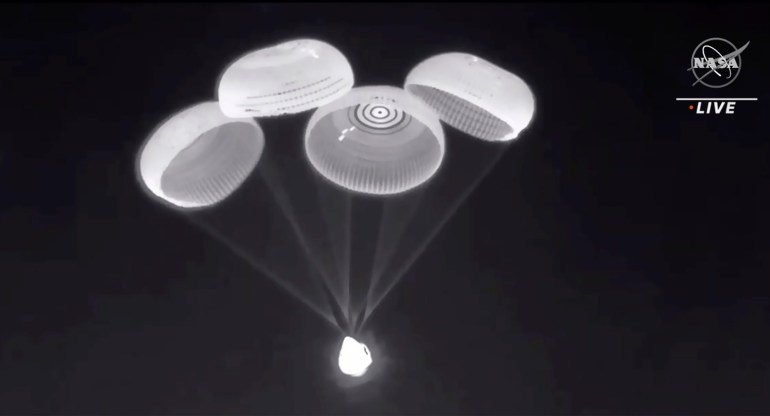Astronauts return to earth after a six-month scientific mission on the International Space Station.
Four astronauts strapped inside a SpaceX Crew Dragon capsule splashed down safely in the Gulf of Mexico off the coast of Florida after a six-month scientific mission on the International Space Station (ISS).
The Dragon vehicle, dubbed Endeavour, parachuted into the sea as planned just after 10:30pm local time on Monday (03:30GMT on Tuesday), following a fiery re-entry and descent that NASA streamed live.
Live thermal video imaging captured a glimpse of the capsule streaking like a meteor through the night sky over the Gulf minutes before splashdown.
There was applause from the flight control centre as the four main parachutes inflated above the capsule, slowing its speed to about 24 kilometres per hour (15 miles per hour) before dropping gently into the calm sea.
“Endeavour, on behalf of SpaceX, welcome home to planet Earth,” flight control told the crew as a safe splashdown was confirmed.
“It’s great to be back,” one of the astronauts radioed in reply.
Since arriving at the ISS on April 24, the crew of two Americans, a Frenchman and one Japanese astronaut, conducted hundreds of experiments and helped upgrade the station’s solar panels.
Their activities have included documenting the planet’s surface to record human-caused changes and natural events, growing Hatch chilli peppers and studying worms to better understand human health changes in space.
 Parachutes are deployed from the SpaceX Dragon capsule to slow its descent [NASA via AP Photo]
Parachutes are deployed from the SpaceX Dragon capsule to slow its descent [NASA via AP Photo]The crew began their eight-hour return voyage to Earth in the Endeavour with a 90-minute loop around the ISS to take photographs, the first such mission since a Russian Soyuz spaceship performed a similar manoeuvre in 2018.
The Dragon, which flew mostly autonomously, has a small circular window at the top of its forward hatch through which the astronauts can point their cameras.
“Proud to have represented France once again in space! Next stop, the Moon?” tweeted Thomas Pesquet from the European Space Agency.
The capsule re-entered the atmosphere at more than 27,000km/h (about 17,000mph), during which crew communications were lost for several minutes.
The intense friction generated as the capsule plunges through the atmosphere also sends temperatures surrounding the outside of the vehicle soaring to 3,500F (1,927C), and a heat shield protects the capsule from incinerating on re-entry.
Recovery vessels were shown headed towards the water-proof Crew Dragon as it bobbed upright in the water. The astronauts and their capsule were expected to be hoisted out of the sea within about an hour, NASA said.
The crew’s departure was delayed by a day because of strong winds.
Bad weather and what NASA called a “minor medical issue” have also pushed back the launch of the next set of astronauts – the Crew-3 mission – which is now set to launch on Wednesday.
Until then, there will be only three astronauts on the ISS – two Russians and one American.
https://news.google.com/__i/rss/rd/articles/CBMiWWh0dHBzOi8vd3d3LmFsamF6ZWVyYS5jb20vbmV3cy8yMDIxLzExLzkvbmFzYS1zcGFjZXgtY3Jldy1zcGxhc2hlcy1kb3duLWluLWd1bGYtb2YtbWV4aWNv0gFdaHR0cHM6Ly93d3cuYWxqYXplZXJhLmNvbS9hbXAvbmV3cy8yMDIxLzExLzkvbmFzYS1zcGFjZXgtY3Jldy1zcGxhc2hlcy1kb3duLWluLWd1bGYtb2YtbWV4aWNv?oc=5
2021-11-09 05:12:25Z
CAIiEOvIpoJIkt6RmGZldOc4oQ8qFQgEKgwIACoFCAowhgIwkDgws_qTBw
Tidak ada komentar:
Posting Komentar